Ryan Hall's Blog, page 178
March 30, 2017
American Olympians To Take On International Rivals At Carlsbad 5000
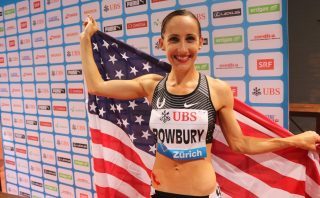
Shannon Rowbury after winning the 1500m in the Weltklasse in Zurich, Switzerland, in 2016. Photo: Chris Lotsbom
(c) 2017 Race Results Weekly, all rights reserved
The world’s fastest 5K road race, the Carlsbad 5000 in Carlsbad, Calif., returns on Sunday, April 2, and will feature U.S. Olympians Shannon Rowbury, Paul Chelimo and Brenda Martinez facing a strong international field. The 32nd edition of the race, which will be run on the original course that has not been used the last two years, is the home of both the men’s and women’s Association of Road Racing Statisticians (ARRS) world records of 12:59.5 and 14:46, respectively.
Rowbury, 32, who finished fourth in the Rio Olympics 1500m, will make her third Carlsbad appearance, and her first since 2013 when she finished sixth. She could have her eye on Molly Huddle’s American record of 14:50 set at the B.A.A. 5K in 2015. Rowbury already holds the American 5000m record of 14:38.92 set at the Brussels Diamond League meeting last September.
“San Diego and Carlsbad are just stunningly beautiful,” said Rowbury, who grew up in San Francisco and now lives in Portland, Ore. “To be able to race in front of a U.S. crowd, I love it. And the course is stunning. I’m excited to open the outdoor season with a road race. This is a fun opportunity to start the season on a beautiful course that I’ve enjoyed in the past.”
Although Martinez, 29, is more of an 800/1500m runner, she is well known for her hard road workouts near her home in Big Bear Lake, Calif., and is a veteran of four Carlsbad 5000’s. Her best mark at Carlsbad is 15:24 from 2014, which was good for fourth place, and her 5000m personal best is a respectable 15:30.89.
Other top American women entered are Lauren Paquette (5000m PB of 15:14.45), Neely Spence Gracey (15:25.34), and Christy Cazzola (16:21.49). From overseas, Sweden’s Sarah Lahti (15:10.76 PB) has the fastest 5000m time, but Olympians Viola Lagat of Kenya (15:35.12) and Dominique Scott of South Africa (15:25.10) are also threats to make the podium.
PHOTOS: 2016 Carlsbad 5000
On the men’s side, the 26-year-old Chelimo won the silver medal in Rio in the 5000m last summer and has a career best time of 13:03.90. However, he is not the fastest, nor most decorated, man in the field, a distinction which belongs to Ethiopia’s Dejen Gebremeskel, the 2012 Olympic 5000m silver medalist who has a personal best of 12:46.81. Gebremeskel has already won Carlsbad a record four times.
“I’m excited to be coming back to Carlsbad to race over 5000m,” Gebremeskel said in a statement. “It’s one of my favorite races in the world and I have won there many times. As always it will be tough (to win) as the competition is always strong, but I hope that I can add another title to my collection.”
Other contenders for the podium include Britain’s Andy Vernon (13:11.50 PB) and Tom Lancashire (13:34.44); Australia’s Collis Birmingham (13:09.57), Brett Robinson (13:18.96), and Sam McEntee (13:20.72); Dutchman Jesper van der Wielen (13:29.02); and Americans Will Leer (13:21.55) and Mac Fleet (3:38.35 1500m PB).
Since the inaugural edition in 1986, the Carlsbad 5000 has seen 16 world records, eight U.S. records, along with numerous national and age-group marks.
RELATED: A Look At The Runners Who Have Done All 30 Carlsbad 5000s
The post American Olympians To Take On International Rivals At Carlsbad 5000 appeared first on Competitor.com.
The Expert’s On-The-Course Guide To Spectating The Boston Marathon
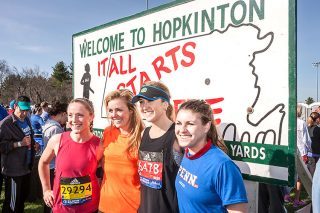
The Athlete's Village iconic welcome sign at the Boston Marathon start.
The Boston Marathon is just a few short weeks away. If you are a runner coming with fans in tow, you might be wondering where they can spot you out on the course. Or maybe you’re headed up to catch the elites or cheer for a friend. Either way, we’ve got you covered.
A point-to-point course that begins in the quaint town of Hopkinton, the Boston Marathon affords multiple opportunities to see runners throughout the day. Depending on your viewing priorities, you can watch all 27,000 runners pass you by, or find a certain someone in multiple locations. The key is having a plan and not flying by the seat of your pants.
Pick a spot
Chicago’s Mark Buciak, 56, will be starting his 37th consecutive Boston this year and has brought friends and family members every time. “I have a high school friend who I think has the record for a non-Bostonian with the most races spectated,” he laughs.
Buciak’s recommendation for spectating? Pick a spot and camp out for the day. “If you think about it, only two miles of the race are actually in the city, so finding transportation to many of the other spots is difficult,” he says.
While you might assume that the finish line is the best place to set up shop, Buciak says no. “It’s a madhouse there,” he says. “Even if you do see your runner, waiting for them to then get through the chute after the finish takes forever.”
Instead, he sends all his friends to the 24.5-mile marker, the location of Anthony’s Townhouse in Brookline. “Townhouses in New England are bed and breakfasts without the breakfast,” Buciak explains. “The hosts, Barbara and Anthony, welcome everyone there—you can even use the restroom.”
To get there, take the Greenline C train to the St. Mary’s stop. Buciak says you can see your runner easily through the crowds, plus you are surrounded by thousands of cheering fans. “As a runner, I love seeing my friends and family there,” he explains. “It sets me up for a great final two miles.”
While you wait for your runner to pass by, satisfy hunger at the Busy Bee restaurant right across the street from Anthony’s. “They’ve got the best blueberry pancakes in the world,” says Buciak.
Once your runner has passed by, Buciak recommends then walking the final miles back to the finish line rather than taking the crowded T back. “This approach will probably get you back around the same time that your runner has finally made it out of the finishing area,” he says.
Move around
While Buciak is a fan of the one-stop approach to spectating, others prefer to move around to catch their runners more than once. Maryland-based Nancy Burns, 63, has run Boston once herself, but has cheered on husband Bob, 64, on 10 different occasions. She has both camped out at one spot, as well as mastered the art of watching for Bob at multiple locations.
Burns says that her spectating plan has changed over the years as the race has grown in size and popularity. “Years ago, we could drive to a spot to watch and then drive back down to the finish after,” she says. “Now it’s more of an ordeal.”
Traditionally, Burns’ favorite spot is on Commonwealth Avenue around the 19– or 20-mile marker, where the crowds are big but not so deep that you can’t spot your runner. “Most runners are hurting here and can use some cheering,” she says. “There is a wide median strip, porta-potties, and food kiosks, so you have everything you need.”
Over the past few years, Burns has opted to catch Bob around the 16.5-mile marker, in between the famous Wellesley wall and Newton Hills. She takes the Greenline Riverside to the Woodland Station stop and then walks about a half-mile to the course. “If your runner is moving, you can watch them here and then get back to the T to catch them again by the Prudential Center,” she says. “You have to be willing to hustle and know that you’re going to be packed in like a sardine on the train, however.”
Burns has tried various locations over the years, including Cleveland Circle at about mile 22 or so. “This was a great place to watch, but Bob couldn’t hear me over the crowds,” she says. “It’s also tough to get a good spot here unless you arrive early.”
When to head out to your spectator’s vantage point depends on your choice in locale. “I used to drive Bob to Hopkinton, then watch the start on TV before heading out to cheer, Burns says. “Now you have to get out much earlier if you want a good location.”
RELATED: Boston Marathon Spectating Tips From TV Announcer Craig Masback
Celebrate after
Regardless of your preference and approach to spectating, once the race is said and done you’ll want to rendezvous with your runner and celebrate. Burns likes to meet up with Bob at McCormick and Schmick’s in the Park Plaza hotel, just a few blocks from the finish line. “This has become a favorite meeting spot for runners from our club,” she says. “It’s easy to reach and isn’t overly crowded.”
Buciak also hits the Park Plaza right after the race for a quick celebration drink. Then he likes to clean up and head a bit further afield to the North End. “I like going to Al Dente restaurant on Salem Street,” he says. “Then it’s a short 150 steps to Bova’s Bakery. That’s the real reason I come back to Boston.”
No matter how you slice it, watching Boston is an entertaining endeavor, maybe almost as fun as running the race itself. “I encourage all runners to go watch it at least once,” Buciak says. “Run the 5K the day before, experience the expo, and then watch the ‘super bowl of running’ on Patriot’s Day.”
Rules of the game
Since the 2013 bombing, the Boston Athletic Association (B.A.A.) has established some guidelines for spectators along the course. If you’re going, be prepared to follow a few rules and suggestions:
Keep all personal items under your immediate supervision at all times.
Be prepared for screening points at various points along the course.
Do not bring or use drones along the course.
Spectators are encouraged to carry personal items in clear plastic bags to expedite security screenings.
Security discourages spectators from carrying backpacks, coolers, suitcases, large blankets, large and bulky items, and costumes.
RELATED: Why The Boston Marathon Is So Special
The post The Expert’s On-The-Course Guide To Spectating The Boston Marathon appeared first on Competitor.com.
March 29, 2017
Traditional Shoe Brands Taking On Athleisure Style
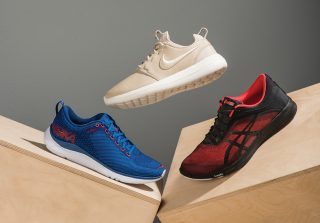
Hoka One One Hupana ($115), Nike Roshe Two SI ($130), ASICS fuzeX Rush ($100); Photo: Oliver Baker
What the heck is “athleisure”? In a nutshell, athleisure is the term given to shoes, apparel and accessories that are athletically inspired but really meant for more casual, lifestyle use. In other words, they’re high-tech sneakers that are comfortable and chill without looking overly sporty.
The main drivers of the trend, according to many sneakerheads, running retailers and shoe brands, were the original Nike Free in 2004 and Nike’s Roshe Run shoe in 2012.
The Nike Free line was originally developed based on performance aspects of barefoot or natural running. While the Swoosh created the Free line to be used as legitimate running shoes, it quickly found out that many people were wearing them in everyday pursuits.
Same goes for Roshe Run, which was designed by acclaimed designer Dylan Raasch as a lifestyle shoe first, without considering any performance aspects. The goal was to create a hip, comfortable street shoe with a hint of athletic style. The original Roshe Run ($75) and the Roshe Two ($100) have been a huge hit.
Fast forward to 2017 and you can find numerous athleisure-oriented sneakers available from traditional running brands like Nike, Hoka One One, ASICS, New Balance, Adidas and more.
In addition to the many iterations of Nike’s Free and Roshe Run and Roshe Two models, we also like the Hoka One One Hupana and ASICS fuzeX Rush. If there’s a common theme to those it’s that they’re meant to be comfortable and stylish, regardless of what you do when you wear them, and all are suitable for gym workouts or short-distance running.
No matter what kind of runner you are, stick to shoes meant for regular running. But if you are an active, fit person who wants to show a hint of style in casual settings, get yourself some athleisure kicks this spring.
RELATED: What’s Old Is Cool Again—Vintage Running Shoes
The post Traditional Shoe Brands Taking On Athleisure Style appeared first on Competitor.com.
Does Compression Gear Actually Work?
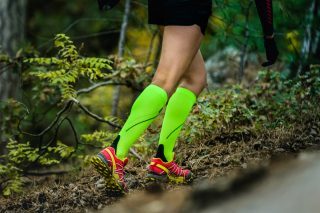
Photo: Shutterstock
Do you wear compression apparel during or after a run? Are you considering making a purchase? If so, a new study may make you reconsider why or what type of compression you need.
Recently, a study in the 2016 Journal of Sports Medicine found that compression wear had no statistical effect on running performance, as measured by race times in the half marathon, 15K trail run, 5K and 1oK runs, and 400-meter sprint. The report concluded that wearing lower leg compression does not significantly change running mechanics or oxygen consumption while running at a speed less than a full-on sprint. These findings were based on the compilation of research and studies that found a lack of significant differences in VO2 and running mechanics at any speed between the control and experimental groups.
However the study did find some value in compression wear. Because individual metabolic and gait response to wearing lower leg compression varies greatly, runners may see improvements in endurance performance, measured by “time to exhaustion, better running economy, biomechanics, perceived performance, and muscle temperature.” Further, the report found that runners may benefit from reduced muscle pain, damage, and inflammation. They even found that compression exerted a large positive effect on post-exercise leg soreness and delay in the onset of muscle fatigue.
To complicate these findings further, there are differences based on the type of lower leg compression garment runners choose: socks, sleeves, shorts or full-length tights. Moreover, there are differences between brands and the strength of the compression pressure their garments provide, not to mention where on the lower leg they place that pressure—although the Journal of Sports Medicine report did not name specific brands.
So should you still purchase compression gear? According to the studies, compression may not offer much benefit during runs, but it could for some athletes with the right variables. However, wearing it after your run should help with muscle recovery. If you think you fall into the category of runners who benefit from compression, check to see whether and where it compresses. Not all compression is created equal and may have the opposite effect of providing compression that could hinder circulation.
RELATED: 5 Compression Options For Endurance Athletes
The post Does Compression Gear Actually Work? appeared first on Competitor.com.
Turkish Runners Banned For Doping; Will Lose Olympic And World Championship Medals
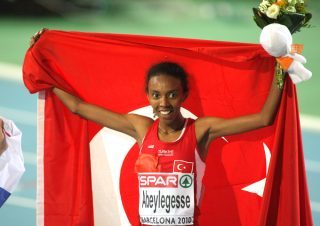
Elvan Abeylegesse, Photo: Shutterstock
On Wednesday, Turkish runners Elvan Abeylegesse and Gamze Bulut were banned for doping by the International Association of Athletics Federations (IAAF).
Abeylegesse retroactively failed a doping test on a sample taken at the 2007 World Championships. She has been banned from the sport for two years, and her results between 2007 to 2009 have been voided. Abeylegesse is also set to lose her Olympic silver medals in the 5,000 and 10,000 meters, won at the 2008 Beijing Games, and a silver medal in the 10,000m from the 2007 world championships.
Shalane Flanagan, who finished third in the 10,000m in the 2008 Olympics, will now be upgraded to the silver medal, with bronze going to Linet Chepkwemoi Masai of Kenya. Via Twitter, Flanagan said she was “elated” at the news but “I still have never been contacted by @iaaforg or IOC about next step…”
Elated to receive this news.heard this was possible 2 years ago. I still have never been contacted by @iaaforg or IOC about next step… https://t.co/IJNo6Xjyjy
— Shalane Flanagan (@ShalaneFlanagan) March 29, 2017
In the 5,000m, Meseret Defar of Ethiopia would get silver and Sylvia Kibet of Kenya would get bronze.
As for the 2007 World Championships, Kara Goucher would now be awarded the silver medal, with Great Britain’s Jo Pavey receiving bronze. Goucher tweeted that she was excited but noted that the “mental/emotional/financial anguish of this has been difficult.” Pavey told The Guardian that she “would have preferred to have been on the podium in Osaka [Japan] but it is good to have a resolution.”
Humbled by all the lovely messages. Thank you. It will feel real when I can hold the medal in my hands. ❤️ pic.twitter.com/anvAiw8dNu
— Kara Goucher (@karagoucher) March 29, 2017
Bulet has been given a four-year suspension by the IAAF for a violation of her biological passport. She will lose her silver medal in the 1,500 at the 2012 London Olympics.
RELATED: What Motivates Some Runners To Cheat?
The post Turkish Runners Banned For Doping; Will Lose Olympic And World Championship Medals appeared first on Competitor.com.
March 28, 2017
5 Foods Full Of Nutrients That Are In Season This Spring

You’ve probably heard the rule of the grocery store: Stick to the outer portion for the healthiest foods. If you’re looking for whole foods, why not focus on the produce section and pick up some fruits and vegetables that are in season? Whether your diet is plant-based or you regularly eat meat, you’ll get much-needed nutrients from these fresh choices. Eating seasonally is recommended, as you’ll get the highest quality and wider range of foods in your diet. Since these are all in season in the spring, you’ll get the best pickings to prepare.
RELATED: What Runners Should Know About Micronutrients





The post 5 Foods Full Of Nutrients That Are In Season This Spring appeared first on Competitor.com.
How to Eliminate Walk Breaks During Your Run
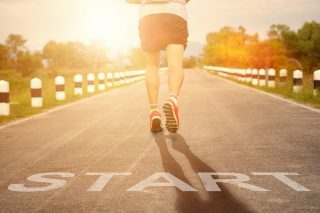
Photo: Shutterstock
For new runners, walk breaks are a common training tool used to help manage longer distances when first building fitness. They serve a helpful purpose. Just like during an interval workout, the walk break is a recovery period that accomplishes a few important goals:
Walk breaks reduce heart rate, preventing new runners from working too hard on what should otherwise be an easy run.
It allows beginners to finish longer distances than they could with just running alone.
The psychology of a walk break allows beginners to easily tackle longer runs from a mental perspective. It doesn’t seem as challenging when you can stop to walk!
Clearly, there are good reasons to stop and walk during a run. But should walk breaks be used indefinitely?
As a coach, my answer is no. Walk breaks soon stop serving their purpose once a runner reaches a certain fitness level Just like training wheels on a child’s bike are not used forever, neither are walk breaks.
The fitness needed to eliminate breaks is not too substantial. Beginner runners can complete all of their mileage much sooner than they realize!
How to transition away from walk breaks
First, it’s helpful to understand why many runners utilize walk breaks when they first start training. It’s a common belief that walking during a run prevents running injuries. However there is no evidence to support that idea. Taking several 1 to 2-minute walk breaks during a 30-minute run only reduces the volume of running by a mile or less. That’s not significant enough to provide any injury prevention benefit.
Instead, walk breaks should be viewed as a stepping stone to more sustained, consistent running. After 4 to 6 weeks of steady exercise, most runners will be ready to limit their walk breaks—and soon, completely eliminate them from their running.
The first thing you can do to eliminate breaks is to reduce the duration of the walking interval by 30 seconds or a minute. If you are used to walking for two minutes, try a 90-second or 1-minute walk break.
RELATED: The Benefits Of Running For Time
Once the walk break is reduced to a minute or less for 1 to 2 weeks, runners are ready to take less frequent walk breaks. If you typically run 2 minutes, walk 1 minute, then it can be extended to run 3 minutes, walk 1 minute. Keep repeating this pattern until you are soon running for 7 to 10 minutes before a short, 30-second walk break.
This progressive, gradual approach has multiple benefits:
It prevents the runner from running too much, too soon.
It’s mentally manageable so runners won’t get frustrated.
Running for longer stretches of 5 to 10 minutes builds self-confidence as fitness level increases.
Once you can run for 7 to 10 minutes before needing to stop for a brief walk period, it’s time to take the next step: a “walk only as needed” approach. Instead of eliminating walk breaks completely, an “as needed” philosophy gives the runner the chance to walk with no guilt, while still adapting to running for longer periods of time. Athletes should walk only when they feel like their heart rate is getting too high or their breath is labored. An easy run should be comfortable, controlled and conversational.
After 2 to 3 weeks of using the “as needed” approach to walking, the vast majority of runners will be able to successfully transition away from walking. They will soon be running the entirety of their weekly mileage without needing to stop and walk.
Of course, if you feel like you need to stop and walk, then you should! High temperatures, humidity, altitude and even wind are all obstacles that make running more difficult.
With fewer walking stops, runners will increase their confidence, be able to run higher weekly mileage and successfully improve their fitness. And the best part—you will also be a lot faster too!
RELATED: A 5K Training Plan For Beginners
The post How to Eliminate Walk Breaks During Your Run appeared first on Competitor.com.
13.1 Things to Know About Running A Half Marathon
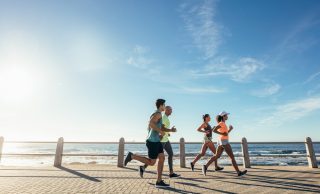
Photo: Shutterstock
If 5Ks and 10Ks are starting to lose their thrill, it just may be time to up your mileage, and make the jump to a half marathon. According to Running USA, the 13.1-mile distance had the second highest number of finishers in 2015. (5Ks were the most popular distance.) Last year nearly two million runners toed the line at 2,700 half marathons in the U.S., meaning more options than you can imagine. Want to run a half in every state, dressed in a costume, in a different country, in a big city, on a trail—you can lace up for all of this and more!
For the goal-oriented amongst us, there are already some wicked speedy half marathon world records in place. According to the International Association of Athletic Federations (IAAF), the men’s record is 58:23, set by Zersenay Tadese of Eritrea in 2010. For women, Peres Jepchirchir of Kenya set a new record of 1:05:06 this past February.
Now that the pressure is off, it’s time to focus on what you need to know to run 13.1 miles, and, hopefully, have a blast!
1) Make sure you’re sure.
Event related Instagram posts usually show the adrenaline-drenched glory of crossing a finish line and the joy of the post-race celebration. They don’t necessarily portray the blisters, sweaty efforts and unforeseen challenges that go into training for a half. Because, here’s the thing—you have to train.
2) You may be able to go from the couch to the finish line without training, but it will hurt.
A lot. Training is essential to make the most of your goal, avoid injury and enjoy the experience. But it’s also not as simple as cobbling together a few interesting runs. Aim to have a decent base, in the range of 15-20 miles a week, and make sure you are willing to commit to the process. Then….
3) Pick a plan.
If you have a spring half on your calendar, you should be well into your training. If you are eyeing a summer race, now is the time to get busy and decide on a training program in line with your fitness level and race goals. There’s no need to compare your efforts or program with colleagues or friends. You do you!
RELATED: 12-Week Half Marathon Training Program
4) Ease into training.
Running lots of miles may sound fun at first. But you want to be smart about ramping up, especially if this is your first half or if you haven’t trained in a while. You want to reach your goal healthy and ready for more, not exhausted and injured. Success comes in consistency. You need more than just a couple of long or fast runs. Quality miles and cross training are your friends.
5) Speaking of cross training, now is the time to get serious about it.
Yes, you need to put in the miles to condition your legs, feet, lungs and heart for the rigors of running 13.1 miles. But your body will also benefit from switching up activities like mobility work (consider a weekly yoga class), weights, HIIT workouts or even a weekly swim or bike ride.
6) Sleep. Seriously.
Sleeping is some of the best recovery time because it’s passive rehabilitation. You don’t have to do a thing—no rolling, stretching or focus required. How much zzz’s your body needs varies from person to person, but experts suggest seven to nine hours nightly. Deena Kastor, the American record holder for the half marathon with a time of 1:07:34, likes to get 10 hours of sleep per night.
7) Eat Smart.
A 5-mile training run does not justify eating half of a pizza. If you’re around 150 pounds and running 12-minute miles, you’ll burn roughly 600 calories on your run. Aim for a slice or two, and a salad instead.
RELATED: Nutrition Tweaks for Half-Marathon Training
8) Get some new gear.
You don’t need a lot, but you want enough to run comfortably. Start with a visit to your local running store for new shoes. Be sure to let them size you. The extra effort just may save your toenails and make for more enjoyable running. Ladies, this is also the time to get fitted for a new running bra. Sports bras only last about a year and you should have three in rotation.
9) Join a running group.
While some people thrive on alone time, going the distance solo can get lonely for others. When you’re getting new gear, ask about local running groups or weekly runs. It’s a great way to meet like-minded people. The conversation and camaraderie helps miles to fly by. You may even be inspired to push your pace a bit!
10) Communicate with your family and friends.
You will need a good support system during training. Let your family and friends in on your goals and what it’s going to take to get there. The last thing you want is for them to write you off as a jerk because you stopped attending Thursday happy hour. Suggest meeting for brunch after your Sunday miles or ask them to join you on their bikes while you run. If that doesn’t work, including them in the post-race celebrations certainly will. However, too much communication can be a bad thing. Chances are they don’t want the TMI updates about your chafing or runner’s trots, and eyes will quickly glaze over when you begin relaying your latest splits. Save those details for the new friends you make in your running group.
11) Take care of yourself.
Get a massage, book maintenance visits to a physical therapist, foam roll, try cryotherapy or just stretch. This is the time to show your body some love. Simply thinking about foam rolling while it collects dust doesn’t count. Taking 5-10 minutes every day to address twinges before they become bigger problems is critical to long-term running success. Set a time and stick to it—first thing in the morning, after your run, while watching TV. Keeping yourself healthy is well worth the investment.
RELATED: Self-Message Tips For Runners
12) Familiarize yourself with the course.
Once you’ve prepped physically, be sure to strengthen your mental game. For home races, you may be able to train on parts of the course, ride the route on your bike or drive it. If you’re traveling to a race, you can still study the course and elevation profile, as well as figure out when and where you’ll take advantage of aid stations. Knowing what to expect makes you better able to handle race day challenges.
13) Save the celebrations for after your race.
Nerves can get the best of anyone, but the night or two before a race is best enjoyed with feet up, sleeping or catching up on your favorite shows. And hydrating with lots of water.
13.1) Enjoy the process!
Remember, you’re doing this as a personal challenge and to have fun. Do I need to point out that this is a hobby? Sure, it’s hard and it may hurt, but you trained and forked over good money for the experience—make the most of it!
The post 13.1 Things to Know About Running A Half Marathon appeared first on Competitor.com.
Costumes, Charity and Spring Cheer At Boston’s Hop 21 Training Run
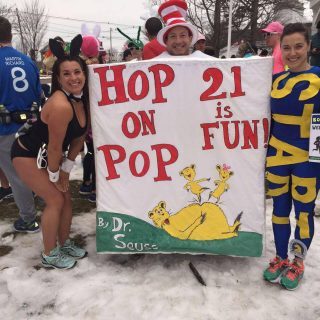
Cheery spring-themed costumes helped brighten the spirits of about 2,000 runners who were out for their last long run before the Boston Marathon at Saturday’s Charity Teams Hop 21. Created by Susan Hurley of Charity Runners, the traditional training run from Hopkinton to Heart Break Hill (about 21.5 miles) has also become a popular community day for charity runners and those training for the Boston Marathon. Hurley buses charity runners from Boston to Hopkinton for the event, organizes aid stations along the route and makes the final long run a cause of celebration, complete with a post-run party! Check out the scenes and costumes from this year’s edition held on March 25.
RELATED: Boston’s Hop 21 Is Making The Long Training Run Fun Again



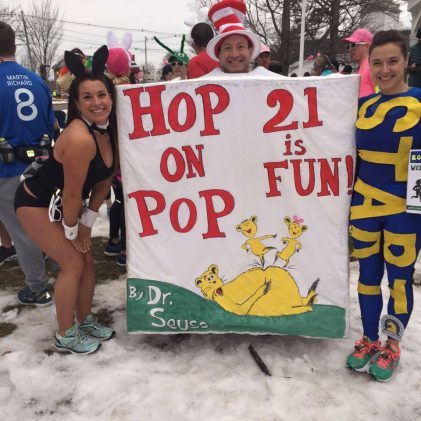
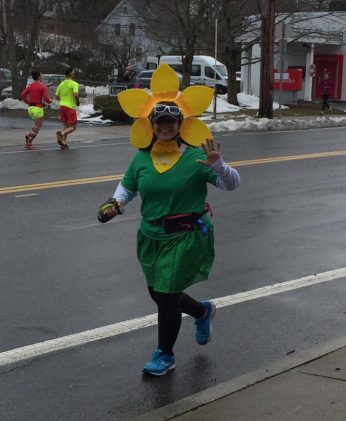
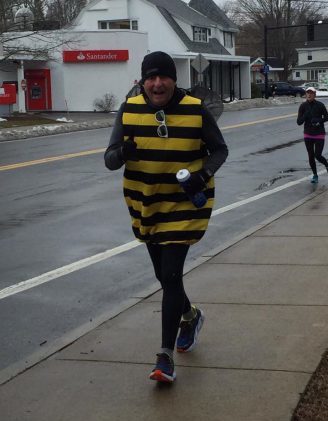

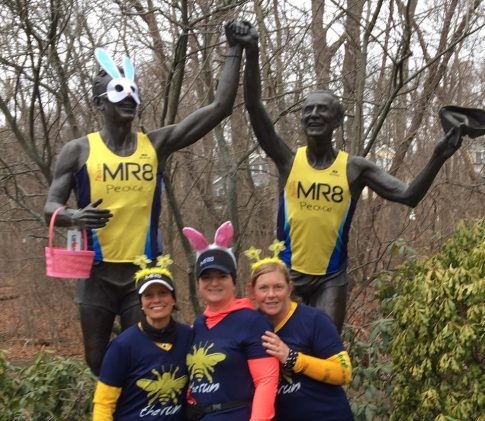

The post Costumes, Charity and Spring Cheer At Boston’s Hop 21 Training Run appeared first on Competitor.com.
March 27, 2017
Boston Marathon Spectating Tips From TV Announcer Craig Masback
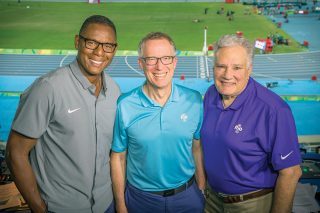
Craig Masback (middle) at the 2016 Rio Olympic Games. Photo by: Paul Drinkwater, Courtesy of NBC Sports
Former American middle-distance runner Craig Masback has one of the best second careers around: He makes the call for all of NBC Sports’ coverage of track and field and road racing—including five Olympic Games. On April 17, aside Tim Hutchings, Masback will be the co-commentator for the 121st Boston Marathon. We asked him for his take on this year’s race.
What are you most excited about in this year’s Boston Marathon?
The fact that the Americans have a legitimate chance to win both the men’s and women’s races. All three members of last summer’s U.S. Olympic marathon team—Galen Rupp, Meb Keflezighi and Jared Ward—are running. Desiree Linden, who finished in the top 10 in Rio and has run well in Boston in the past, is running. Also, the men’s race has the current world record holder, Dennis Kimetto, and a former world record holder, Patrick Makau, both of Kenya, as well as the defending Boston winner, Lemi Berhanu Hayle of Ethiopia.
What advice do you have for the first-time Boston Marathon Viewer?
My best advice is patience, and, if possible, a commitment to watching the whole race. Boston is unique—there’s an unusual amount of action for a marathon because it’s so easy for runners to start the race at a fast clip due to the downhill nature of the first half of the race. However, running too fast too early inevitably leads to issues later in the race when the runners face a series of hills. If we do our job correctly, we’ll document the strategic elements of the race and the personal stories of the runners, which should give first-time viewers plenty to follow and several people to root for.
What’s the secret to making a three-hour race dramatic and watchable?
In addition to what I said earlier, some of the best ways to make it “dramatic” are to shut up and let the natural sound of the race tell the story. No marathon in the world has a better, more knowledgeable crowd than Boston, and the enthusiasm of the crowd is compelling. This will be especially true if an American is a serious contender for the win.
*The Boston Marathon airs live on Monday, April 17, at 8:30 a.m. EST on NBCSN, and will be live streamed on NBCSports.com and the NBC Sports app.
The post Boston Marathon Spectating Tips From TV Announcer Craig Masback appeared first on Competitor.com.
Ryan Hall's Blog
- Ryan Hall's profile
- 21 followers



